Contents
Market Overview
Macro Review
Dollar shorts quail as U.S. Treasury yields rose. Several important developments occurred this week that shifted monetary policy in a more hawkish direction: the Fed’s Clarida and Evans deviated from their dovish positions, ISM data offered green-shoots and Non-Farm Payrolls exceeded expectations. Indeed, the weak ADP report on Wednesday initially took U.S. Treasuries to the lowest yields (1.13% on the 10yr), although it is so often a poor predictor of U.S. jobs which was proved once again on Friday (unemployment dipped to 5.4% from 5.9%). The 10yr U.S. Treasury closed the week at 1.28%, which is some 6bp wider overall, just as 5s30s flattened 3bp. U.S. equities otherwise hit new all-time highs as earnings petered through and GS even revised their S&P 500 forecast to 4700 from 4300. The hawkish undertone of central banks extended to Brazil as the Cocom hiked 100bp, which is the largest increment since 2003 and the largest EM hike after Russia only in the previous week. Markets were otherwise focused on global PMIs as China’s services PMI topped 54.5 and reached the highest level since December. Elsewhere, South Africa’s cabinet reshuffle had a mild impact on the market with ZAR weakening 1%, with 5yr CDS moving to 205bp (+4bp wider) as sovereign bonds weakened 2-4bp (more on this below).
EM Credit Update
EM Credit ended last week up 0.4% with spreads tightening 3bp tighter. Outperformers on the week include Suriname, Tunisia and Zambia, while El Salvador, Ghana and Nigeria lagged.
The Week Ahead
After a strong NFP we would expect attention to shift to U.S. inflation. The U.S. CPI print is due next Wednesday, which risks reapplying pressure on Chair Powell at Jackson Hole. However, amidst the upward pressure on U.S. Treasuries, markets will brace for Chinese CPI at the same time, while PPI is expected to edge up to 8.9%. Inflation is the common theme next week, with releases due from Brazil, Czech Republic, India, Mexico, Poland and Romania. Meanwhile, Turkey’s CBRT rates decision next Thursday is expected to be lively after Erdogan’s recent comments (19.0%), more so than the dovish stance out of Philippines (2.0%), and mildly hawkish setting in Peru (0.25%) and Mexico (4.25%). Then Brazil’s Cocom will publish MPC minutes, just as the market seeks further clarity on the next 100bp hike anticipated in September. Away from that, we would expect to see a healthy rebound in 2Q GDP out of Russia.
Highlights from emerging markets discussed below include: Market-preferred Pedro Francke accepted appointment as Peru’s Economic and Finance Minister, downside risks remain elevated; Tunisia’s future still uncertain despite recent cabinet reshuffle; and Brazil’s precatorios proposal makes marginal room for further social support under spending cap.
Fixed Income
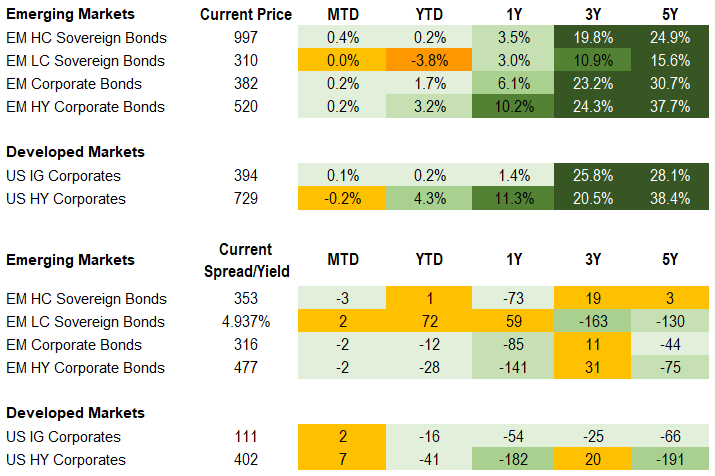
Equities
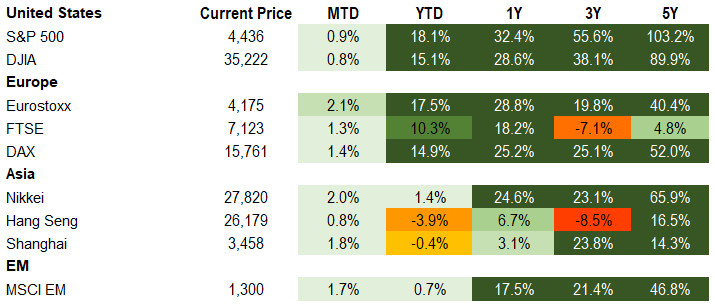
Commodities

Source for data tables: Bloomberg, JPMorgan, Gramercy. EM Fixed Income is represented by the following JPMorgan Indicies: EMBI Global, GBI-EM Global Diversified, CEMBI Broad Diversified and CEMBI Broad High Yield. DM Fixed Income is represented by the JPMorgan JULI Total Return Index and Domestic High Yield Index. Fixed Income, Equity and Commodity data is as of August 6, 2021 (Mid Afternoon).
Emerging Markets Weekly Highlights
Market-preferred Pedro Francke accepted appointment as Peru’s Economic and Finance Minister; downside risks remain elevated
Event: President Castillo appointed his economic advisor and former World Bank economist Pedro Francke as Economic and Finance Minister after a period of uncertainty last week. Congress now must provide a vote of confidence on the cabinet. At the time of writing, Julio Velarde’s role and ultimate tenure as Central Bank Governor still remained uncertain.
Gramercy Commentary: The comparatively more moderate, albeit still leftist, choice of Pedro Francke as Economic and Finance minister was in line with market expectations and contributed to stabilization in asset prices over the week. The focus now shifts to confirmation of Velarde’s position at the Central Bank, congressional approval of the cabinet, as well as initial policy action. Aside from Franke, the overall unorthodox tilt and controversial nature of many of the cabinet members, notably PM Guido Bellido and Foreign Affairs Minister Hector Cevallos who reportedly have ELN (National Liberation Army) and Shining Path ties, still leave a risk of a failed confidence vote. In the event of two failed confidence votes, new congressional elections would be called within four months. While a possibility, it seems more probable that Congress would avoid this given it would risk expanding Peru Libre’s position in government. Regardless, governability challenges and policy uncertainty are likely to remain high. We continue to see asymmetric downside risk to Peruvian assets with the scope for near term weakness, particularly on the local side, dependent on the Central Bank Governor selection, associated credibility implications, and policy actions thereafter.
Tunisia’s future still uncertain despite recent cabinet reshuffle
Event: After the series of events last week in Tunisia, including the firing of the then Prime Minister and the suspension of the Parliament for 30 days, President Kai Saied has replaced key personnel at various ministries. Most notably, he has appointed a new interim Finance Minister, Sihem Boughdiri Nemsia. At the time of writing, he has not yet appointed a Prime Minister, but the nomination is expected in the coming days before the 30-day suspension lapses.
Gramercy Commentary: In our view, the appointment of an experienced bureaucrat as interim Finance Minister is moderately constructive for navigation of the political crisis while clarification on the new Prime Minister will be an important signal for momentum going forward. Ms. Boughdiri Nemsia is expected to transition relatively smoothly into her new role given her background as the former Director General responsible for tax studies and fiscal legislation and her experiences in dealing with the IMF and other international donors. In initial meetings, she has emphasized restoration of trust with international financial institutions and investors. If current Central Bank Governor Marouane Abassi is appointed Prime Minister as rumored, this should open space for Saied to develop a mandate and roadmap for national dialogue. While the stated intent is for negotiations with the IMF over a new program to conclude by year-end, management of the domestic political environment will likely result in a more prolonged path than envisaged to multilateral assistance and drive further volatility in the interim.
Brazil’s precatorios proposal makes marginal room for further social support under spending cap
Event: In the coming days, the administration will submit to Congress a constitutional amendment proposal (PEC) to pay large precatorios (court-ordered debt defined by the judiciary branch) in installments as precatorios are increasing significantly from BRL 55bn in 2021 to BRL 90bn in 2022. In addition, the Administration’s proposal also includes an establishment of a special purpose fund, which will be capitalized by one-off revenue collected by the government (e.g. proceeds from privatization) and will not be counted towards the spending cap. The fund would be used to accelerate the precatorios installment schedule and make non-recurring bonuses towards social welfare.
Gramercy Commentary: The precatorios amendment would provide an estimated BRL 10bn in room under the spending cap, likely to be utilized by the upsizing and modification of the social welfare program Bolsa Familia (reported increase in monthly payments to BRL 300 from BRL 190). The limited appetite to increase the spending cap and keep the program upsize contained is positive from a fiscal management standpoint. However, the proposed social dividends financed by privatization outside of the spending cap presents downside risks to fiscal policy, potentially creating a precedent of spending outside of the cap and lowering predictability and transparency. Given these challenges, we believe that this aspect of the proposal may face some pushback in Congress and has potential for modification.
South Africa’s cabinet shuffle unlikely to materially change policy outlook
Event: Following last month’s social unrest, President Cyril Ramaphosa made several changes to his cabinet this week with the most notable adjustment at the National Treasury, which will now be led by Enoch Godongwana. Godongwana has been a long-time Head of Economic Policy and held previous positions as Deputy Minister of Public Enterprises and Deputy Minister of Economic Development. In sum, new ministers have been appointed across ten ministries, including health, defense, tourism, water and sanitation, small business as well as communications and digital technology.
Gramercy Commentary: Godongwana’s experience within the ruling Africa National Congress (ANC), pragmatic approach, and loyalty to President Ramaphosa, largely ease concerns over the transition amid a busy period ahead of the medium term budget statement as well as increased pressure for new social spending in the backdrop of recent unrest. The cabinet changes in combination with control over protests reflect a degree of power consolidation on the part of Ramaphosa which could be positive over the medium term for structural reform and investment. In the near term, there is likelihood for a marginal increase in additional spending which may partially erode YTD revenue outperformance slowing deficit consolidation.
Emerging Markets Technicals
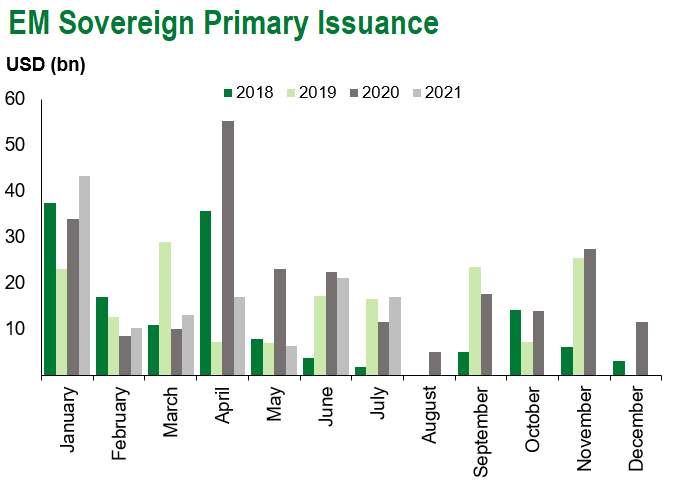
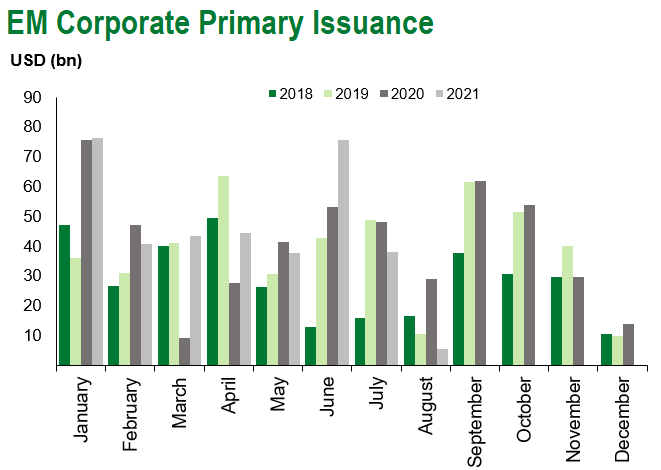
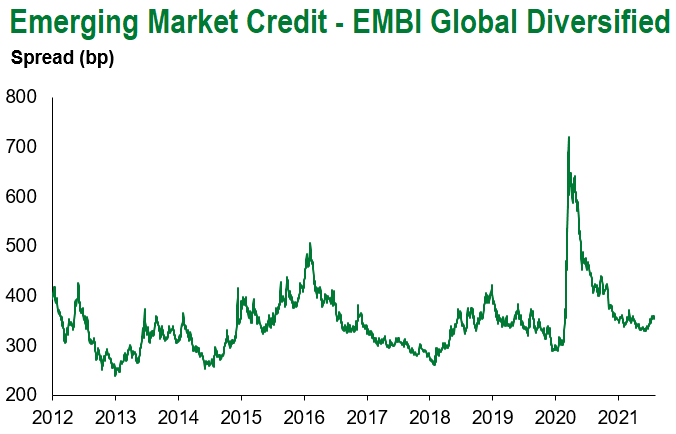
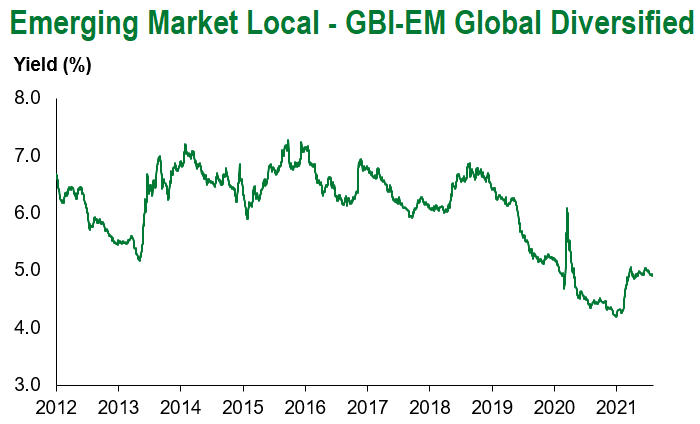
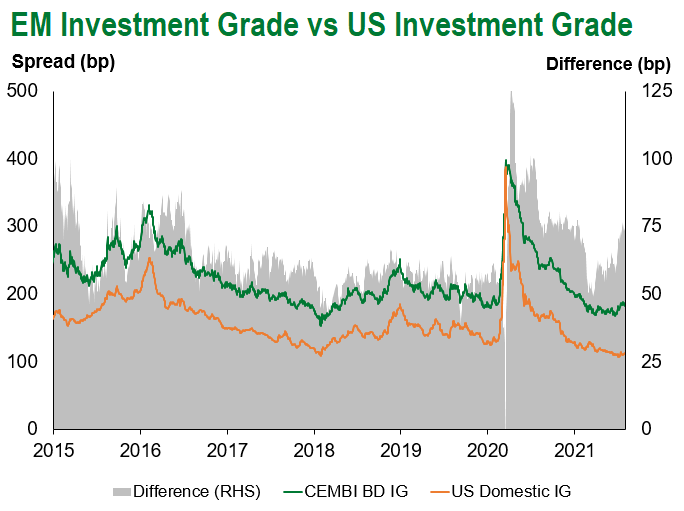
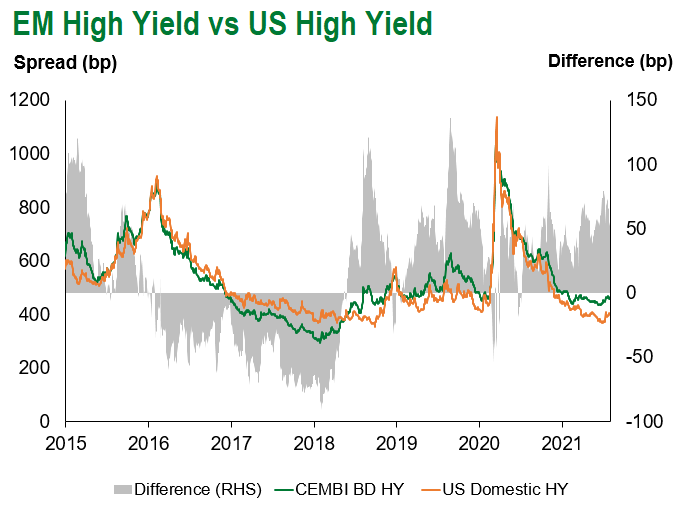
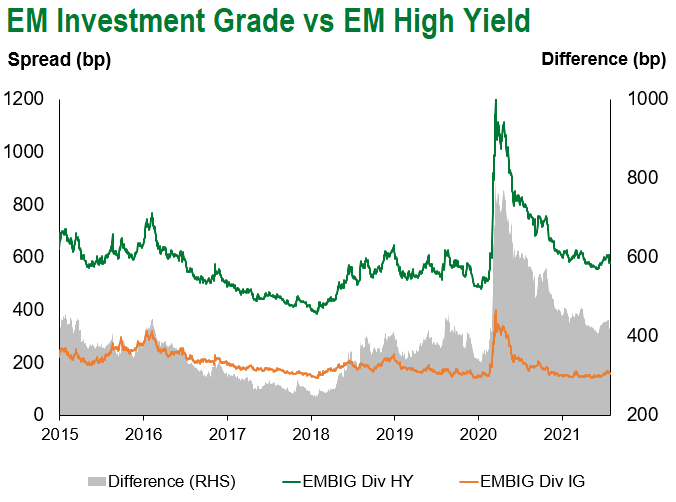
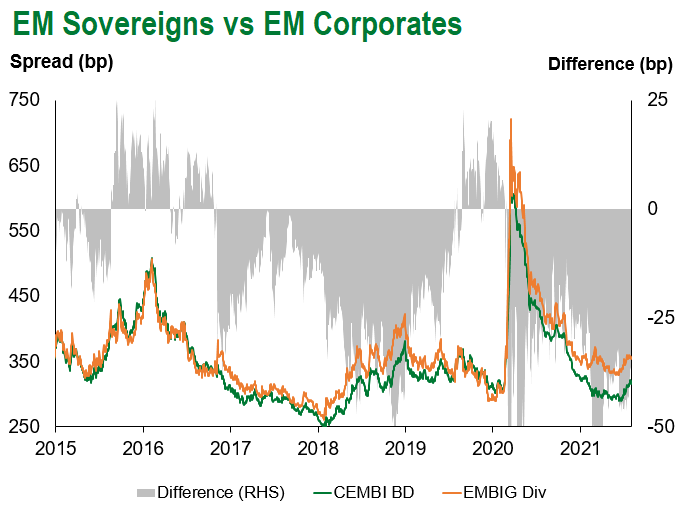
Emerging Markets Flows
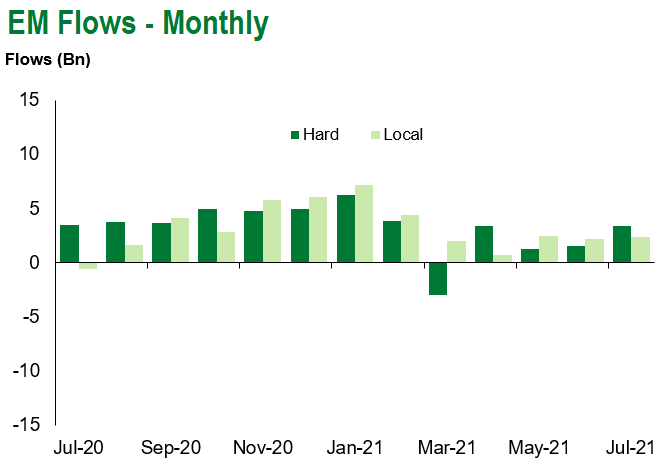
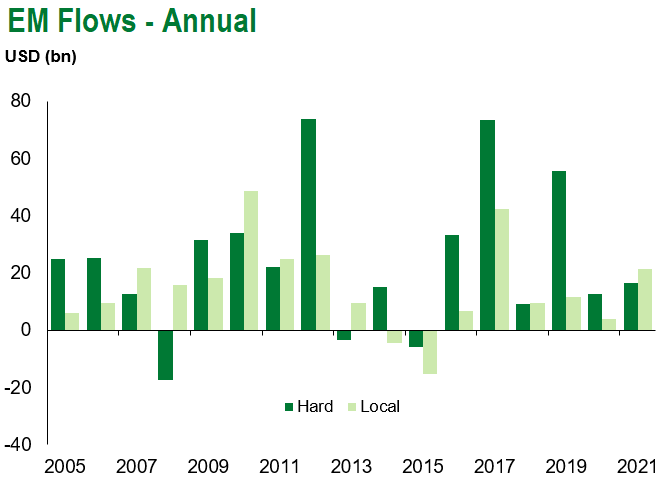
Source for graphs: Bloomberg, JPMorgan, Gramercy. As of August 6, 2021.
COVID Resources
Emerging Markets COVID-19 Case Summary
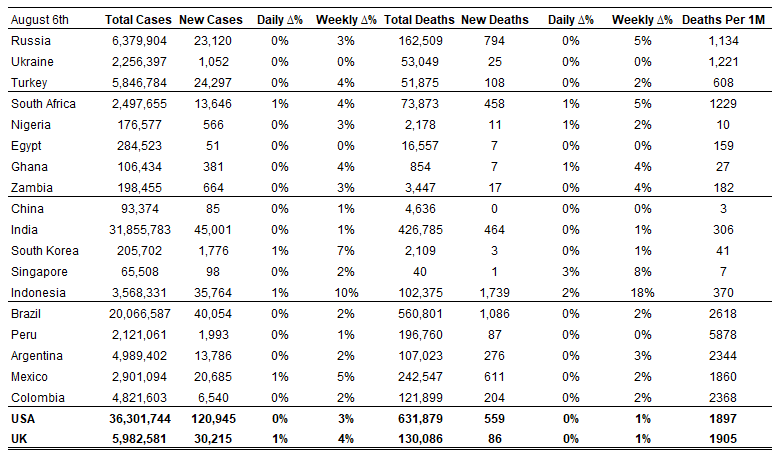
Source: Worldometer as of August 6, 2021.
Additional Crisis Resources:
Johns Hopkins COVID-19 Case Tracker
For questions, please contact:
Kathryn Exum, Senior Vice President, Sovereign Research Analyst, [email protected]
Petar Atanasov, Senior Vice President, Sovereign Research Analyst, [email protected]
Tolu Alamutu, CFA, Senior Vice President, Corporate Research Analyst, [email protected]
James Barry, Vice President, Corporate Research Analyst, [email protected]
This document is for informational purposes only. The information presented is not intended to be relied upon as a forecast, research or investment advice, and is not a recommendation, offer or solicitation to buy or sell any securities or to adopt any investment strategy. Gramercy may have current investment positions in the securities or sovereigns mentioned above. The information and opinions contained in this paper are as of the date of initial publication, derived from proprietary and nonproprietary sources deemed by Gramercy to be reliable, are not necessarily all-inclusive and are not guaranteed as to accuracy. This paper may contain “forward-looking” information that is not purely historical in nature. Such information may include, among other things, projections and forecasts. There is no guarantee that any forecasts made will come to pass. Reliance upon information in this paper is at the sole discretion of the reader. You should not rely on this presentation as the basis upon which to make an investment decision. Investment involves risk. There can be no assurance that investment objectives will be achieved. Investors must be prepared to bear the risk of a total loss of their investment. These risks are often heightened for investments in emerging/developing markets or smaller capital markets. International investing involves risks, including risks related to foreign currency, limited liquidity, less government regulation, and the possibility of substantial volatility due to adverse political, economic or other developments. The information provided herein is neither tax nor legal advice. Investors should speak to their tax professional for specific information regarding their tax situation.